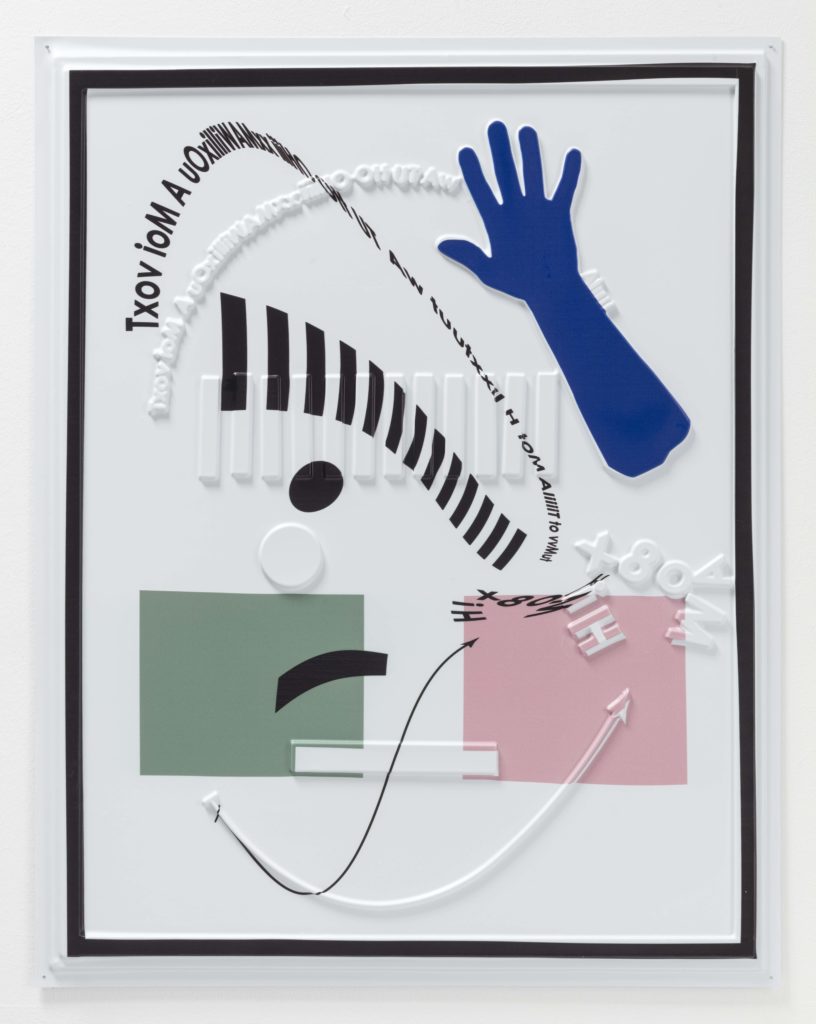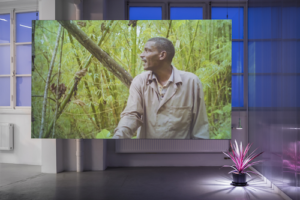“I’m concerned with language as abstraction, and the exploration of space, perception and interpretation as procedural components of both,” artist José León Cerrillo quickly told me in conversation about his vacuum-formed reliefs from his Echo series (2017), presented by Stockholm-based gallery Andrehn-Schiptjenko, during the fifth edition of Material Art Fair, Mexico City. Thematic linkages of his work could be found elsewhere in other exhibitions at the fair, which ran from February 8 to 11. This vibrant marketplace of ideas, much like Cerrillo’s pieces, culminated in a global discussion about, among other things, the creation of meaning, non-hegemonic forms of knowledge, and the changing dynamics of the body with respect to contentious and evolving matrices of being.

With representation from 78 galleries, 18 countries, and 33 cities, the fair felt more accessible than it did alienating. Participants and galleries, both emerging and established, were keen on developing an intimate rapport with patrons about the works and building unique relationships that promoted a sense of nurturing and conviviality. The common thread uniting each booth in the fair was by-and-large the freedom of expression. In a country marred in recent years by drug-fueled corruption and a crackdown on politically-alternative voices, this year’s iteration of the fair sought to highlight the common spaces of resistance being created by local and international creative communities. The procession of such a task registered at the intersection of personal and collective memory that takes various textures of material culture as its constructive platform.
With their respective offsite contributions, Mexico City-based Lulu and Almanaque Fotografica aptly characterized the utility of cross-border, aesthetic dialogues. Lulu’s The Lulennial II: A Low-Hanging Fruit took place at the gallery’s conservatively-sized space in Roma Sur, and featured works by artists like Nancy Lupo, Jef Geys, Meriem Bennani, Kelly Akashi, and Yuji Agematsu. The auxiliary event, curated by Lulu co-founder Chris Sharp and writer Andrew Berardini featured renditions and interpretation of the complex and dynamic metaphor of fruit, marking a reflexively dichotomous relationship with the seasoned geographic characteristics of Mexico City within the egalitarian environment of humor and gastronomic affinities.

Almanaque Fotografica’s Making Appear, an exhibition of photography observing articulations of sensuality and place, gestured at making the commonalities of expression visible. Through a sharp programme organized by French curator Aurélie Vandewynckele, the project also showcased an enviable local and international roster with inclusions by Paul Mpagi Sepuya, Aglae Cortés, Julie Escoffier, Manuel H. Márquez, and Ellie de Verdier. Photography here served as a indelible, utilitarian dialct for relaying and ensuring the visibility of concealed yet shared moments. More importantly, in examining the shifting territories of photography and sculpture, the show looked to dispel “illusionary territories that occur inside and outside of the image,” effectively opening up space for possible interpretations and deconstructions of space and body.
For galleries such as David Fierman (NYC), Syndicate (Cologne), Gianni Manhattan (Vienna), and others, the interplay of personal narratives and history took on immanent political dimensions.Fierman artist Cristine Brache’s genealogical porcelain sculptures interrogate the essentializing mysticism of memory and affiliation, utilizing this framework as a resource for conceptualizing and confronting identity. Brache’s Birthday Party 1994 (2018) and Halloween 1992 (2018) — both porcelain replicas of VHS family home video, loose black ribbon on flesh-colored silicone — attempt to reconcile the effect of being linked to a specific, coded history that at once feels impenetrable by virtue of social repetition, and penetrable by way of personal memory and choreography. In these pieces, VHS tapes are material representations of hegemonic totalization of individual and class subjectivity; one that specifically prioritizes “externalized directness” over what she claims as the potentially disruptive mechanics of indirectness and understatement. By signaling to their destruction, she weaponizes the situation of marginalized people, including her own agitations with the socially-determined conditions of femininity, in order to strategically act against the troubling machinations of late capitalism and patriarchy.
Similarly, Los Angeles-based artist Magdalena Kita’s immediate, dream-like, figurative icons in her booth presentation at Syndicate are largely concerned with an internal dialogue about negotiating the self using collapsed forms of mythology. Her characters, rendered in colorful paintings with effervescent textures, play with the multifaceted dimensions of femininity, carefully mediated through the accessible vernacular of humour to allow resonations in a variety of viewers. Magdalena’s pieces function as an exercise in telling the story of difference, emotively illustrated via a painting language that borrows from Byzantine calligraphy, folklore and Art Brut. Speaking with Kita, she informed me her primary motivation stems from questioning the generative characteristic of myth, using it as a way to navigate her iconographic forms in an ostensibly universal scripture.

Barbara Kapusta’s video and sculptural works in the Gianni Manhattan booth mobilized the affective forces of language and sensuality to dictate a uniquely welcoming space of networked embraces. On the floor were textual arrangements made of vinyl lettering paired with variably-sized sculptures featured in her film ‘Emphatic Creatures‘ (2018): white porcelain brackets, black-pigmented porcelain 8s, and white-pigmented brackets and 0s. These objects are, to the artist, Companions, existing in dynamic, symbiotic conversation with other objects on view, and are based on philosopher Donna Haraway’s Companion Species. Kapusta’s work looks to channel forms of empathetic response from text, sculpture and animation, organizing them as interfaces and conduits for relating with worlds either in the process of becoming or already palpable. In so doing, she ultimately hopes to craft broader context for mediating simultaneity and nonlinearity, as well as the contingent relationships between bodies and surfaces; implicating these geographies as both sites of production and ecologies knowledge.
Brooklyn-based 315 Gallery, showing dark, decadent figurative paintings alongside silicone epidermal structures by artists Haley Josephs and Amy Brener, respectively, produced another standout booth. Though both works elicit divergent visceral responses due to starkly different artistic processes, the unity of conversation that occured when viewed in tandem, again, speaks to the polyvalences of identity formed by close relationships to technoculture and the volatile economic landscape. Furthermore, Joseph’s Imitator (2018) — a feminine, demonic caricature — and Brener’s Flexi-Shield Expecta series (2018) excelled in articulating the inherent farce in essentializing the embodied female subject, given its inherent multiplicity and plasticity. Like Kita’s work, these pieces take myth and iconography as their foundational platform in telling the rich, variable story of womanhood against a dynamic gaze.

Bigger and bolder, this year’s Material Art Fair certainly did not disappoint with its vitalizing showcase of photographs, paintings, performances, illustrations, and everything in between. Each booth, auxiliary exhibition and special projects — most notably that of New York bar and curatorial project Beverly’s — found a particularly affirming and rejuvenating energy with every passing moment. Roving influx of patrons added novel layers of understanding, criticality and meaning to the pieces and fair as a whole, contouring the already endowed topologies of context with fresh perspective. As a fair that prides itself on sowing the seeds of emergent dialogues and artistic practices, while blurring the class distinction of borders that can stifle such conversations, coordinators of Material triumphed in organizing an event that was more comprehensive and holistic than exhaustive and atomistic. **
Material Art Fair was on at Mexico City’s Fronton, running February 8 to 11, 2018.














